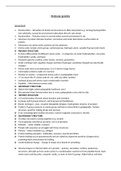Lecture notes
Molecular Genetics
- Module
- Biomedical Sciences
- Institution
- University Of Chester (UoC)
A brief but heavily detailed document containing the core subjects in molecular genetics, including key words and their meanings. This will give you a good understanding of molecular genetics at a second year biomedical science level, without having to take in too much information about each indivi...
[Show more]



